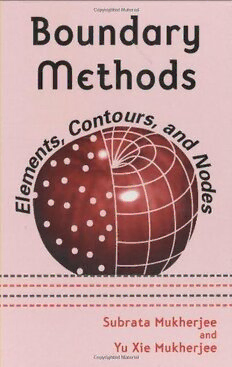Download Boundary Methods: Elements, Contours, and Nodes (Dekker Mechanical Engineering) PDF Free - Full Version
Download Boundary Methods: Elements, Contours, and Nodes (Dekker Mechanical Engineering) by Subrata Mukherjee, Yu Xie Mukherjee in PDF format completely FREE. No registration required, no payment needed. Get instant access to this valuable resource on PDFdrive.to!
About Boundary Methods: Elements, Contours, and Nodes (Dekker Mechanical Engineering)
------------------Description-------------------- Boundary Methods: Elements, Contours, and Nodes presents the results of cutting-edge research in boundary-based mesh-free methods. These methods combine the dimensionality advantage of the boundary element method with the ease of discretization of mesh-free methods, both of which, for some problems, hold distinct advantages over the finite element method. After introducing some novel topics related to the boundary element method (BEM), the authors focus on the boundary contour method (BCM)-a variant of the BEM that further reduces the dimensionality of a problem. The final section of the book explores the boundary node method, which combines the BEM with moving least-squares approximants to produce a mesh-free, boundary-only method. The authors, who are also the primary developers of these methods, clearly introduce and develop each topic. In addition to numerical solutions of boundary value problems in potential theory and linear elasticity, they also discuss topics such as shape sensitivities, shape optimization, and adaptive meshing. Numerical results for selected problems appear throughout the book, as do extensive references. ---------------------Features--------------------- · Introduces novel computational methods that combine the advantages of the boundary element method with those of mesh-free methods · Includes numerical results for many of the problems discussed · Explores applications such as shape sensitivity analysis, shape optimization, and error estimation, analysis, and adaptivity ---------------------Contents--------------------- INTRODUCTION TO BOUNDARY METHODS I SELECTED TOPICS IN BOUNDARY ELEMENT METHODS BOUNDARY INTEGRAL EQUATIONS Potential Theory in Three Dimensions Linear Elasticity in Three Dimensions Nearly Singular Integrals in Linear Elasticity Finite Parts of Hypersingular Equations ERROR ESTIMATION Linear Operators Iterated HBIE and Error Estimation Element-Based Error Indicators Numerical Examples THIN FEATURES Exterior BIE for Potential Theory: MEMS BIE for Elasticity: Cracks and Thin Shells II THE BOUNDARY CONTOUR METHOD LINEAR ELASTICITY Surface and Boundary Contour Equations Hypersingular Boundary Integral Equations Internal Displacements and Stresses Numerical Results SHAPE SENSITIVITY ANALYSIS Sensitivities of Boundary Variables Sensitivities of Surface Stresses Sensitivities of Variables at Internal Points Numerical Results: Hollow Sphere Numerical Results: Block with a Hole SHAPE OPTIMIZATION Shape Optimization Problems Numerical Results ERROR ESTIMATION AND ADAPTIVITY Hypersingular Residuals as Local Error Estimators Adaptive Meshing Strategy Numerical Results III THE BOUNDARY NODE METHOD SURFACE APPROXIMANTS Moving Least Squares (MLS) Approximants Surface Derivatives Weight Functions Use of Cartesian Coordinates POTENTIAL THEORY AND ELASTICITY Potential Theory in Three Dimensions Linear Elasticity in Three Dimensions ADAPTIVITY FOR 3-D POTENTIAL THEORY Hypersingular and Singular Residuals Error Estimation and Adaptive Strategy Progressively Adaptive Solutions: Cube Problem One-Step Adaptive Cell Refinement ADAPTIVITY FOR 3-D LINEAR ELASTICITY Hypersingular and Singular Residuals Error Estimation and Adaptive Strategy Progressively Adaptive Solutions: Pulling a Rod One-Step Adaptive Cell Refinement Bibliography Index
Detailed Information
| Author: | Subrata Mukherjee, Yu Xie Mukherjee |
|---|---|
| Publication Year: | 2005 |
| ISBN: | 9780824725990 |
| Pages: | 235 |
| Language: | English |
| File Size: | 2.741 |
| Format: | |
| Price: | FREE |
Safe & Secure Download - No registration required
Why Choose PDFdrive for Your Free Boundary Methods: Elements, Contours, and Nodes (Dekker Mechanical Engineering) Download?
- 100% Free: No hidden fees or subscriptions required for one book every day.
- No Registration: Immediate access is available without creating accounts for one book every day.
- Safe and Secure: Clean downloads without malware or viruses
- Multiple Formats: PDF, MOBI, Mpub,... optimized for all devices
- Educational Resource: Supporting knowledge sharing and learning
Frequently Asked Questions
Is it really free to download Boundary Methods: Elements, Contours, and Nodes (Dekker Mechanical Engineering) PDF?
Yes, on https://PDFdrive.to you can download Boundary Methods: Elements, Contours, and Nodes (Dekker Mechanical Engineering) by Subrata Mukherjee, Yu Xie Mukherjee completely free. We don't require any payment, subscription, or registration to access this PDF file. For 3 books every day.
How can I read Boundary Methods: Elements, Contours, and Nodes (Dekker Mechanical Engineering) on my mobile device?
After downloading Boundary Methods: Elements, Contours, and Nodes (Dekker Mechanical Engineering) PDF, you can open it with any PDF reader app on your phone or tablet. We recommend using Adobe Acrobat Reader, Apple Books, or Google Play Books for the best reading experience.
Is this the full version of Boundary Methods: Elements, Contours, and Nodes (Dekker Mechanical Engineering)?
Yes, this is the complete PDF version of Boundary Methods: Elements, Contours, and Nodes (Dekker Mechanical Engineering) by Subrata Mukherjee, Yu Xie Mukherjee. You will be able to read the entire content as in the printed version without missing any pages.
Is it legal to download Boundary Methods: Elements, Contours, and Nodes (Dekker Mechanical Engineering) PDF for free?
https://PDFdrive.to provides links to free educational resources available online. We do not store any files on our servers. Please be aware of copyright laws in your country before downloading.
The materials shared are intended for research, educational, and personal use in accordance with fair use principles.

